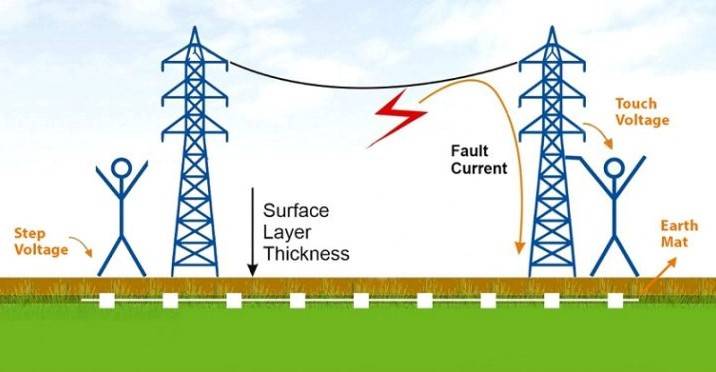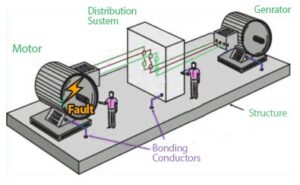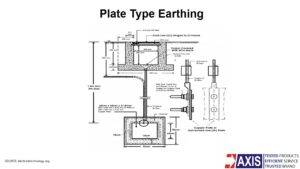An Earth Mat is a mesh formed of bare metallic conductors and buried in shallow soil to provide better safety from touch and step potential. Earth mats are a part of the grounding system implemented in substations, production plants, industrial areas, etc., where high power handling occurs. More efficient grounding methods are required in these places as they deal with high current values. We rely on Earth mats that are the best electrical solutions with a safer grounding technique in such situations. The ultimate aim of earthing is to provide human and equipment safety in a fault situation, this has a greater significance in places like substations industries, hospitals, etc.
Let us understand the situations where earth mats are necessary and why they are significant in such places.
Electric Shock Situations:
The power dealt in places such as power stations and industries is huge. Therefore the impact and dangers caused by them can also be very high. Major situations in substations, power distribution points, telecom towers or other industrial areas that cause an electric shock are listed below.
1. Step Voltage:
It is the difference in surface potential, experienced by a person when he bridges a 1m distance with his feet without touching any other grounded object.
2. Touch Voltage:
The potential difference between the ground potential rise and the surface potential at a point where a person is standing while touching a grounded object is called touch potential.
3. Metal-Metal Touch Voltage:
It occurs when a person standing or touching a grounded object comes in contact with another object that is not grounded or bonded to the ground grid. It is crucial to take every possible precautionary measure to avoid these situations for the safety of individuals working in such places.
How Do Earth Mats Help?
An earth mat consists of individual electrodes that are interlinked. This increases the area in contact with soil and creates several parallel paths for the fault current. The earth resistance is called combined earth value, which is much lower than the individual value.
Earth mats are generally placed in critical operating areas frequently accessed by people.
It is laid at a shallow depth with a high resistive surface material above and a low resistant material beneath it. Earth mats provide earth connections to other non-current carrying metallic objects and act as a ground path for surge arrestors. Thereby keeping the equipment surface at absolute earth potential and thus safe for handling.
Thus earth mats give extra protection to individuals from all the possible electric shocks created by touch and step potential.
Factors Considered While Designing Earth Mats:
The Magnitude of Fault Current: Fault magnitude is the maximum amount of fault current produced in a circuit. It depends on the circuit under consideration and is one of the basic parameters of concern while designing an earth mat. An electrical current of 6mA (for females) and 9mA (for males) is considered the threshold value that can be tolerated without any serious injury. The touch and step potential voltages calculated from the circuit values should be less than the tolerable limit to avoid any emergency. According to IEEE 80, the earth mat is designed keeping these values as a reference.
Soil Resistivity: Soil resistivity is closely related to the moisture-holding capacity of the soil. It differs from region to region according to the climate, soil texture, soil composition, etc. Higher the soil moisture level, lower is the resistivity, and easier is the earthing. So it is recommended that the soil layers below the earth mat must be at lower soil resistivity. In rocky or hard ground situations, earth mat design is done considering the parameters of the region.
The Resistivity of Surface Material: The use of gravel or other surface material about a depth of 3-6inch is highly effective. It reduces the evaporation of moisture from the soil below during dry weather conditions. High-resistive materials used as a surface covering lower the risk of electric shock currents.
Shock Duration: The magnitude and duration of the current through a human body at 50Hz or 60Hz should be less than the value that can cause ventricular fibrillation of the heart, which can otherwise lead to death. Fault current that can be tolerated by a human body of weight 50kg is calculated by the formula:

where t – the time duration of current flow
This shows that the possible intensity of injury or even death due to electric shock reduces considerably if the time duration of current flow is brief.
Material of Earth Mat Conductor: Earth mats are made of materials that have high conductivity and a low corrosion rate. Pure Copper, Copper Bonded GI and GI are the commonly used materials for making earth mats.
Earth Mat Geometry: Earth mat geometry is decided by the standards given in IEEE 80. The calculations proceed considering specific soil resistivity and the possible fault current from the site where the earth mat is required. Then the grid resistance is calculated and from it, the dimension for the earth mat is finalised. Normally sides of the mat are in a ratio 1:1 to 1:3 unless there is an extreme condition.
Watch our video to understand the Role of Earth Mats in Substation!
Are Earth Mats Necessary?
Earth mats are components that enhance the total earthing system of a structure with high power handling and places where sensitive and critical equipment are used. They also play a key role in the early discharge of overvoltages from lightning masts and surge protectors.
The earth mats ensure protection in the following ways:
– It drains out the fault current that occurs
– It maintains the effective earth resistance at the desired value
– It protects from step and touch potential events.
Earth mats provide additional protection to structures such as data centres, hospitals with biomedical instruments, industries, power stations and distribution houses, etc that cannot afford an earth resistance fluctuation. Earth mats are also recommended in places prone to intense lightning strikes and in places that are regularly crowded.
Earth mats are designed based on the requirements mentioned in Standards such as IEEE 80. Several softwares are available for designing earth mats considering real-time inputs a few of them are ETAP, XGS, and CDEGS.
Read more about Earthing & Lightning Protection
Surge Protection Devices (SPD)
Lightning Protection Zones and their Application to SPD Selection
How does a Lightning Arrester work?
Thank you for reading the blog, Axis is a leading manufacturer and supplier of Electrical Components to over 80+ Countries. Talk to our industry expert by visiting our contact us section. You can also watch our videos by our experts – click here.









